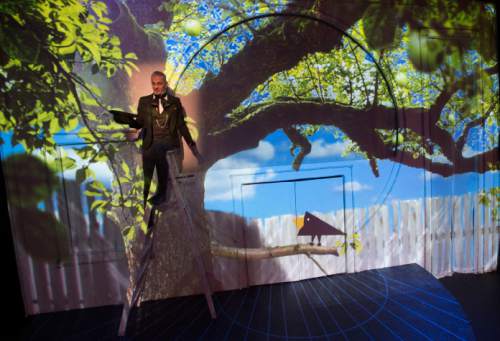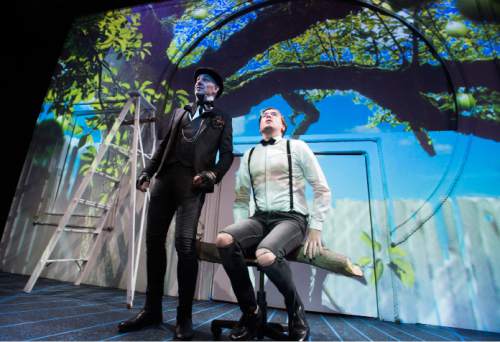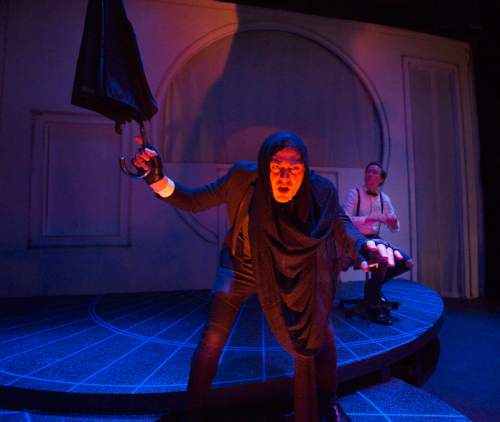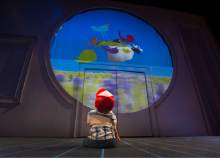This is an archived article that was published on sltrib.com in 2016, and information in the article may be outdated. It is provided only for personal research purposes and may not be reprinted.
Theater companies around the country are increasingly incorporating multimedia into their productions. I first encountered this trend when I saw "War Horse" at Lincoln Center in New York. The stage was completely open, and the set consisted of images projected above it. Portable pieces moved in and out when they were needed.
Some Salt Lake productions have used slides and title cards for some time, but two current productions — Pygmalion's "Selma '65" and Salt Lake Acting Company's "Climbing With Tigers" — depend heavily on a variety of visual effects to involve their audiences. The technique is remarkably effective in both productions.
Catherine Filloux's "Selma '65" profiles two people on opposing sides of the civil-rights struggle in 1960s Alabama. Viola Liuzzo, a white woman from Detroit, has come to participate in the march from Selma to Montgomery because "the right to vote belongs to all of us." The play catches her as she is driving back to Montgomery with Leroy, a young black man, to pick up marchers.
Viola's father once told her to "make a trail of rocks if you get lost," and she uses these rocks to tell her story. Flashbacks reveal her relationship with her husband, Jim, their five children and her black housekeeper and friend Sarah, who she says "always got me off the ledge."
"There's just a fine line that divides us," Viola tells Leroy, and this is also true of her relationship to Tommy Rowe, the play's other character.
Both are Southerners from poor families with very little schooling who have been married three times, but Tommy is clearly a racist. He has infiltrated the Ku Klux Klan to keep the FBI aware of its activities. "I am here because I love the FBI and my country," he says.
He thinks civil-rights activists are communists, and he is obsessed with exposing and eliminating them. As the action of the play accelerates, he is a passenger in a speeding car of Klansmen chasing Viola.
Tracie Merrill plays both Viola and Tommy in a dynamic performance that never wavers in its clarity and dramatic intensity. Director Lane Richins orchestrates her movements — quieter and gentler as Viola and more abrasive and agitated as Tommy — to keep the audience engaged.
But the script works against maintaining emotional momentum as the play builds to a climax. It jumps not only back and forth between the two characters but also backward and forward in time; that does capture the chaos that's occurring, but it makes the action feel disjointed and confusing at times, and the choppiness increases toward the end when the play should be tightest and tensest.
But Thomas George's scenic design and Mikal Troy Klee's projections are direct and powerful. George's stark, symbolic set consists of a chair, section of barbed-wire fence, outline of a highway descending from the ceiling, and suggestion of a noose on the floor. To the left is a screen on which is projected a montage of civil-rights photos and videos along with a repeated image of a lonely road winding away through dark trees. Pilar Davis' atmospheric lighting shifts help us track character and time changes.
"Climbing With Tigers" is a collaborative production on every level. SLAC and Flying Bobcat Theatrical Laboratory are jointly producing the play's world premiere. Playwright Troy Deutsch dramatized the story from the book by Nathan Glad, an 8-year-old with brittle-bone disease, and Dallas Graham, director of the Red Fred Project, which is publishing books written by children with serious illnesses around the country.
The play tells the story of a lonely black bird named Blue. Like Nathan, Blue has "breakable bones" so he is afraid to fly. He spends his life dejectedly perched on a branch in a backyard tree, convinced that the Jolly Troop of other birds wants nothing to do with him. "What haven't you done today? the narrator asks him and the audience. "Scared that you don't know the way?" Blue befriends the Jolly Troop and goes on a great adventure with them to find Thunder Tiger, whose tail has magical powers to heal "the brokenest of the broken." At the end of the play, the narrator reminds the audience that "sometimes your dragons and tigers…could end up helping you with what life has in store."
The story of Blue's journey is imaginative and charming, but what makes "Climbing With Tigers" delightfully unique is the way its two actors interact with projected images and animation. Thomas George's set is a giant screen with hidden doors where the actors can pop out and talk to each other and the audience. Otherwise it displays collaged images and animations created by Jarom Neumann, highlighted by Kevin Mathie's original music. The animated members of the Jolly Troop each have distinctive voices and personalities.
Sometimes the actors merge with the animations and video sequences. My favorite scene features Blue and Thunder Tiger sitting together in a giant opening in the center of the screen to watch the stars, surrounded by images of leaves and branches. Director Alexandra Harbold fluidly integrates live action and animation and keeps everything moving.
As the narrator, Robert Scott Smith proclaims, "I'm here, I'm there, I'm everywhere," and that seems to be true as he encourages Blue, connects with the children in the audience and portrays two other characters, Dred Fred and Thunder Tiger. Austin Archer's Blue grows more confident and relaxed as he overcomes his anxiety and masters challenges.
Jesse Portillo's sunny lighting and Rodney Cuellar's funky costumes — the narrator looks like a cross between a circus ringmaster and Mary Poppins — intensify the production's sense of fun.
"Selma '65" and "Climbing With Tigers" are dramatically different in subject matter and tone, but both are invigorated by visuals that expand their boundaries. It will be interesting to see how future productions continue to integrate technology into storytelling. —
'Selma '65'
Tracie Merrill's inspired performance helps compensate for the fractures in the script of "Selma '65."
When • Reviewed March 4; plays Thursdays, Fridays and Saturdays at 7:30 p.m., and Sundays at 2 p.m., through March 19, with an extra matinee March 19 at 2 p.m.
Where • Leona Wagner Black Box Theatre at the Rose Wagner Performing Arts Center, 138 W. Broadway, Salt Lake City
Tickets • $20; $15 for students and seniors; 801-355-ARTS or artsaltlake.org for tickets, pygmalionproductions.org for information. The play contains adult language and situations.
Running time • One hour (no intermission)
—
'Climbing With Tigers'
A seamless fusion of animation and live action makes "Climbing With Tigers" an eye-catching treat for the whole family.
When • Reviewed March 5; plays Tuesdays through Fridays at 7 p.m., Saturdays at 3 and 7 p.m., and Sundays at 1 and 6 p.m. through March 27
Where • Salt Lake Acting Company, 168 W. 500 North, Salt Lake City
Tickets • $25; $15 for children, with discounts for groups; 801-363-7522 or saltlakeactingcompany.org
Running time • One hour (no intermission)















